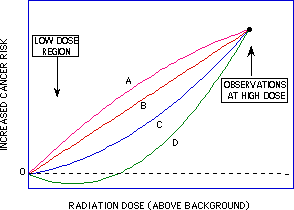 When your doctor recommends a medical procedure, it’s important that you understand the potential benefits and risks involved. There has been much debate in recent years about the relative benefits and risks of imaging procedures that use ionizing radiation, including CT scans and other X-ray exams such as mammography and fluoroscopy.
When your doctor recommends a medical procedure, it’s important that you understand the potential benefits and risks involved. There has been much debate in recent years about the relative benefits and risks of imaging procedures that use ionizing radiation, including CT scans and other X-ray exams such as mammography and fluoroscopy.
A guiding principle in radiology is “ALARA,” or “as low as reasonably achievable.” This principle, based on the assumption that any amount of ionizing radiation increases a person’s risk of developing cancer to some degree, directs radiology professionals to deliver the lowest possible radiation dose needed to acquire needed medical information. At Iowa Radiology, we adhere to this guiding principle to make our X-ray procedures as safe as they can be.
Debate Over Radiation Risks
Recent studies, however, have been questioning the assumption that any level of radiation is harmful. This assumption has been based on interpretations of data collected on survivors of the atomic bombs that were dropped on Hiroshima and Nagasaki during World War II. Critics contend that these interpretations are flawed, and they offer arguments for abandoning the “linear, no-threshold” (LNT) model of radiation risk, which assumes that cancer risk is directly proportional to radiation exposure and that there is no safe dose.[1] These critics contend that the LNT model has led to unjustified fears about radiological imaging and results in a real risk of harm as a result of avoiding procedures that could benefit patients.[2]
Opponents of the LNT model also point to evidence that supports the notion that low doses of radiation are safe and can even provide some protection from subsequent damage—an effect known as hormesis.[3] Researchers who advance this hypothesis about the relationship between radiation dose and cancer risk cite evidence from various studies that tend to show a decreased risk of cancer in subjects who are exposed to low levels of radiation, with risk increasing at higher levels of exposure. While experts have not reached a consensus on the actual effects of low doses of radiation, this graph published by the National Council on Radiation Protection and Measurements illustrates the difference in correlation using the LNT model (line B) and a hormesis model (line D).[4]

A 2005 report published by the French Academy of Sciences and National Academy of Medicine raised doubts about the validity of using the LNT model for evaluating cancer risk associated with radiation doses below 100 mSv[5]—a level many times higher than that delivered by common imaging procedures.[6] While the debate continues, however, the LNT model and the ALARA principal continue to guide public policy, as they represent the most conservative approach to radiation use and minimizes the potential for radiation-induced harm.
Keeping Radiation Exposure Low
At Iowa Radiology, we are committed to protecting patient safety, which includes limiting radiation dose. We begin by working with referring providers to ensure that tests that are ordered are appropriate for obtaining important medical information while delivering the lowest possible radiation dose to the patient. In addition to CT and X-ray exams, we also provide ultrasound and MRI, which do not use ionizing radiation. When X-ray or CT imaging is indicated, we adhere to the ALARA principle. To achieve the lowest reasonable radiation dose for an exam,
- We invest in high quality imaging technology that reduces radiation dose. We utilize SAFIRE technology for CT scans, which can reduce radiation dose by up to 60% while enhancing image quality, and C-View technology for our 3-D mammograms, which reduces both radiation dose and compression time for enhanced safety and comfort.
- We follow CT protocols to adjust radiation dose according to patient size, the purpose for imaging, and the body part being examined.
- We take steps to direct radiation only to the area of clinical interest and shield other parts of the body from unnecessary radiation.
- We take all safety measures necessary to earn accreditation from the American College of Radiology.
If you have questions about any procedure scheduled or performed at one of our clinics, don’t hesitate to call us and ask. We’re committed to delivering the very best in patient care, which includes providing you will all the information you need to make important decisions about your health care. For more specific information about CT scans or 3-D mammography, check out our free materials by clicking the links below.
[1] Socol & Dobrzyński. "Atomic Bomb Survivors Life-Span Study: Insufficient Statistical Power to Select Radiation Carcinogenesis Model." Dose-Response. National Center for Biotechnology Information, 4 May 2015. Web. 20 July 2017.
[2] Society of Nuclear Medicine. "Fear of diagnostic low-dose radiation exposure is overstated, experts assert." ScienceDaily, 9 January 2017. Web. 20 July 2017.
[3] Doss. "Linear No-Threshold Model VS. Radiation Hormesis." Dose-Response. National Center for Biotechnology Information, 24 May 2013. Web. 20 July 2017.
[4] "Radiation Effects at Low Doses." LBL.gov. National Council on Radiation Protection and Measurements, 9 Aug 2000. Web. 20 July 2017.
[5] Tubiana M, et al. “Dose-effect relationships and estimation of carcinogenic effects of low doses of ionizing radiation.” Acad Sci, Nat Acad Med (France) 2005.
[6] "Radiation Dose in X-Ray and CT Exams." Radiologyinfo.org. Radiological Society of North America, n.d. Web. 20 July 2017.
The information contained in the Iowa Radiology website is presented as public service information only. It is not intended to be nor is it a substitute for professional medical advice. You should always seek the advice of your physician or other qualified healthcare provider if you think you may have a medical problem before starting any new treatment, or if you have any questions regarding your medical condition.
Iowa Radiology occasionally supplies links to other web sites as a service to its readers and is not in any way responsible for information provided by other organizations.



